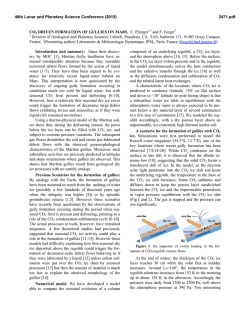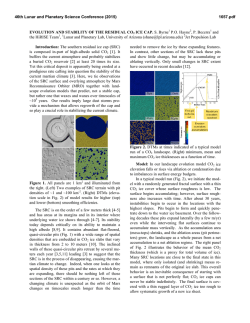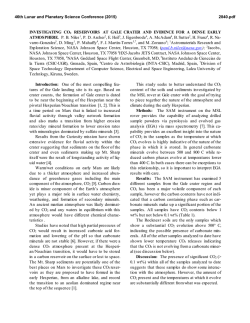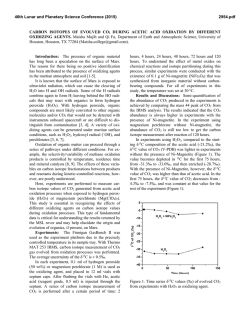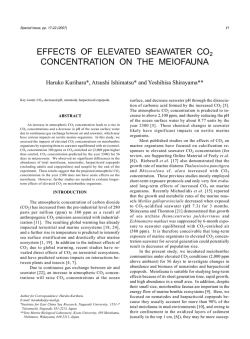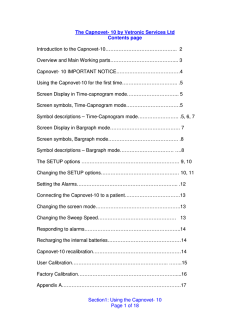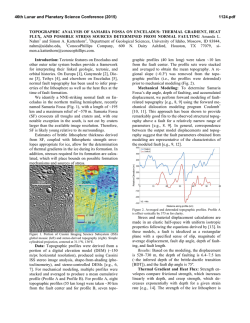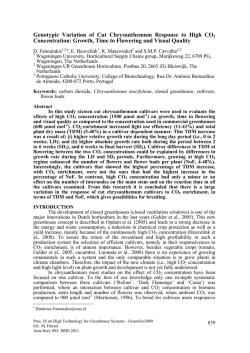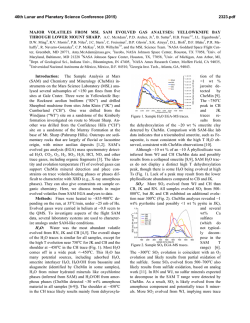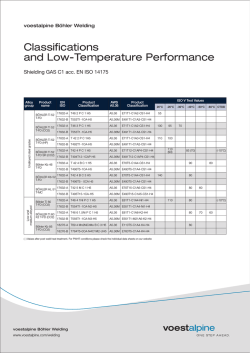
The Mars Diurnal CO
46th Lunar and Planetary Science Conference (2015) 1181.pdf THE MARS DIURNAL CO2 CYCLE AS OBSERVED IN THE THARSIS REGION. T. N. Titus1 and G. E. Cushing1, 1USGS Astrogeology Science Center, 2255 N. Gemini Dr., Flagstaff, AZ 86001 ([email protected]). Introduction: The Mars atmosphere is composed of 95% CO2, and 25% of its mass is cycled through the seasonal CO2 ice caps annually. During the polar night, surface temperatures drop to ~145 K where CO2 ice can begin to directly condense. Atmospheric temperatures can drop to even colder temperatures, allowing for the formation of CO2 snow. During the spring, the CO2 ice sublimes thus completing the annual CO2 cycle. While a significant amount of study has been conducted to characterize and model the annual CO2 cycle, little has been done to investigate the possibility of a diurnal CO2 cycle. Locations: There are two general locations where the diurnal exchange of surface CO2 ice with the atmospheric can occur: (1) the higher elevations of the Tharsis region [1] and (2) the edges of the seasonal polar caps. This presentation will focus on the Tharsis region. The low surface thermal inertia, due to a thick layer of dust, and the low atmospheric pressure of the Tharsis region due to its elevation allows for diurnal temperature ranges from at or near the CO2 frost temperature (~140 K at 2 mbar) during pre-dawn hours to temperatures above the triple point of water during mid-day [1]. Figure 1: Locations and seasons of observed CO2 frost temperatures using TES for Mars Years 26 (top) and 27 (bottom). The location of CO2 ice (overlaid on a MOLA elevation map) is shown on the left; color coded to match the seasons shown on the right. CO2 ice frost temperatures are calculated using a scale height of 10 km and the Viking pressure curve. Data: For this study, we used both the thermal bolometer and spectrometer subsystems of the Mars Global Surveyor (MGS) Thermal Emission Spectrometer (TES) [2] to identify evidence of CO2 ice deposition at 2 AM local time. In addition to TES, we use images from the Mars Odyssey Thermal Emission Imaging System (THEMIS) [3] to identify regions where the surface is at or near the frost point of CO2 at the pre-dawn hours (~ 4 – 5:30 AM). TES Thermal Bolometer Data. The Mars Global Surveyor (MGS) Thermal Emission Spectrometer (TES) [2] observations of the Tharsis region identified temperatures consistent with surface CO2 ice or nearsurface opaque CO2 ice clouds. Fig. 1 shows Mars Year (MY) 26 (top) and MY 27 (bottom). The location of CO2 ice is shown on the left, color coded to match the seasons shown on the right. MY 24 was not complete in seasonal coverage and MY 25 showed no evidence of 2 AM condensation. MY 25 was the year that a global dust storm occurred, which indicates that the overall planetary average temperature might have been higher preceding the onset of the dust storms. This interannual variation suggests that the Tharsis diurnal CO2 cycle may be sensitive to the overall average planetary temperature, and may be a possible indicator of impending global dust storms. TES Thermal Spectral Data. Spectra from the coldest brightness temperature data observed are generally flat through the 25 μm region, suggesting slab or coarse grain CO2 ice. The 15 μm region of the spectra shows a warm atmosphere, suggesting that the formation of CO2 snow is unlikely. Figure 2: Mars Year 32 THEMIS brightness temperatures of Ascraeus Mons at ~5:30 am local time. THEMIS images I53990005 and I54015005 are shown where dark blues are consistent with CO2 frost temperatures (~135 K). Both images were acquired close to southern winter solstice. This figure was created in JAMRS [3] with a MOLA shaded relief map [4] as a background. THEMIS Data. The Mars Odyssey Thermal Emission Imaging System (THEMIS) [5] observations of the Tharsis region identified temperatures consistent 46th Lunar and Planetary Science Conference (2015) with surface CO2 ice. Fig. 2 shows two THEMIS observations acquired at ~5:30 am over Ascraeus Mons. The higher elevations have temperatures consistent with widespread CO2 ice over large areas, but not the caldera itself. Thermal Model: Using the KRC model (Kieffer, 2013) with input parameters defined in Cushing and Titus (2008) and shown in Table 1, a suite of models predicting surface temperatures were generated to form a multidimensional lookup table (or hypercube). The slopes from a MOLA map and latitude are used to construct a 4D hypercube (spatial, local time, season) of the surface temperatures of the Tharsis region. 1181.pdf stricted to Arsia Mons near aphelion and southern winter solstice (Fig. 3) and a second where widespread nightly CO2 deposition occurs during much of the year (Fig. 4). These two examples demonstrate that the Tharsis diurnal CO2 cycle is sensitive to surface thermal inertia. TES observations only suggest CO2 ice deposition on Arsia Mons near aphelion and southern winter solstice at 2 AM while THEMIS observations suggest widespread CO2 ice deposition just prior to dawn, at least near aphelion/winter solstice. If all of the heat lost to space on Arsia Mons (at winter solstice) were converted to CO2 ice, then then CO2 ice accumulation would be approximately 1.6 kg/m3 (~1 mm if deposit is slab ice with no porosity). Table 1: KRC input parameters used for modeling. Figure 4: Possible diurnal CO2 ice deposits predicted by the thermal model for I=50 and A=0.27. The colors indicate season, where blue is Ls 0º, green is ~ Ls 180º and red is Ls 359º. For the model case with lower thermal inertia, wide spread CO2 deposition can occur over a large area of Tharsis and during much of the year. Figure 3: Possible diurnal CO2 ice deposits predicted by the thermal model for thermal inertia, I=76, and Bond albedo, A=0.274. The colors indicate season, where green is aphelion and red is shortly after southern winter solstice. For these parameters, CO2 ice only condenses on Arsia Mons between aphelion and winter solstice. Results: Two examples (Figs. 3-4) are shown, including a case where nightly CO2 deposition is re- Conclusions: Simple energy balance considerations suggest that nightly CO2 deposit, which completely sublimes away shortly after dawn, could be as thick as 1.6 kg/m3. Interannual variations of the Tharsis CO2 cycle suggest sensitivity to the average planetary temperature. Further constraints on the details of the Tharsis diurnal CO2 cycle will be presented. References: [1] Cushing, G.E. & T. N. Titus (2008) JGR, 113, CiteID E06006 [2] Christensen, P. R. et al. (1992) JGR, 97, 7719 [4] JMARS, Ariz. State U. [4] Zuber et al. (1992) JGR, 97, 7781 [5] Christensen et al. (2004) JGR, 109, 8003.
© Copyright 2026
